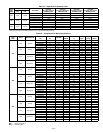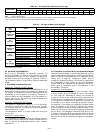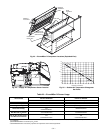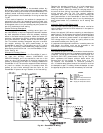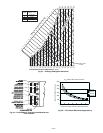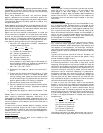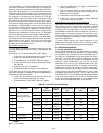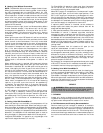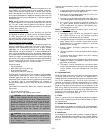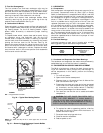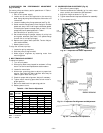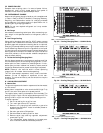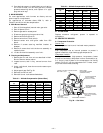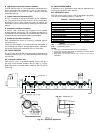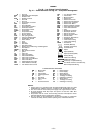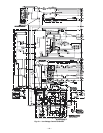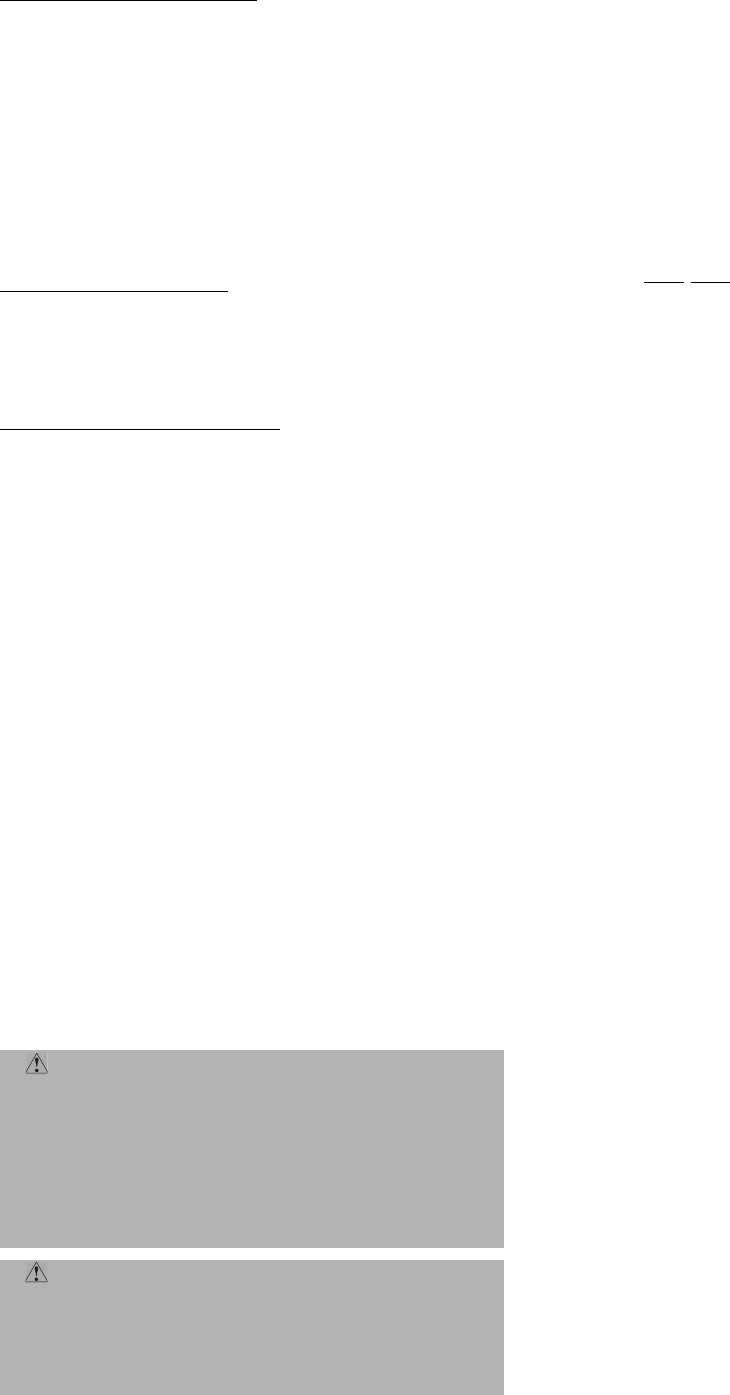
—37—
Remove Surface Loaded Fibers
Surface loaded fibers or dirt should be removed with a vac-
uum cleaner. If a vacuum cleaner is not available, a soft non-
metallic bristle brush may be used. In either case, the tool
should be applied in the direction of the fins. Coil surfaces
can be easily damaged (fin edges can be easily bent over and
damage to the coating of a protected coil) if the tool is applied
across the fins.
NOTE: Use of a water stream, such as a garden hose, against
a surface loaded coil will drive the fibers and dirt into the
coil. This will make cleaning efforts more difficult. Surface
loaded fibers must be completely removed prior to using low
velocity clean water rinse.
Periodic Clean Water Rinse
A periodic clean water rinse is very beneficial for coils that
are applied in coastal or industrial environments. However,
it is very important that the water rinse is made with very
low velocity water stream to avoid damaging the fin edges.
Monthly cleaning as described below is recommended.
Routine Cleaning of Coil Surfaces
Monthly cleaning with Totaline® environmentally sound coil
cleaner is essential to extend the life of coils. This cleaner is
available from Replacement parts division as part number
P902-0301 for a one gallon container, and part number
P902-0305 for a 5 gallon container. It is recommended that all
coils, including standard aluminum, pre-coated, copper/copper
or E-coated coils be cleaned with the Totaline environmentally
sound coil cleaner as described below. Coil cleaning should be
part of the unit’s regularly scheduled maintenance procedures
to ensure long life of the coil. Failure to clean the coils may
result in reduced durability in the environment.
Avoid the use of:
• Coil brighteners
• Acid cleaning prior to painting
• High pressure washers
• Poor quality water for cleaning
Totaline environmentally sound coil cleaner is non-flammable,
hypoallergenic, nonbacterial, and a USDA accepted biode-
gradable agent that will not harm the coil or surrounding
components such as electrical wiring, painted metal surfaces,
or insulation. Use of non-recommended coil cleaners is
strongly discouraged since coil and unit durability could be
affected.
Totaline® Environmentally Sound Coil Cleaner Application
Equipment
•2
1
/
2
gallon garden sprayer
• Water rinse with low velocity spray nozzle
Totaline Environmentally Sound Coil Cleaner Application
Instructions
1. Proper eye protection such as safety glasses is recom-
mended during mixing and application.
2. Remove all surface loaded fibers and dirt with a vac-
uum cleaner as described above.
3. Thoroughly wet finned surfaces with clean water and a
low velocity garden hose, being careful not to bend fins.
4. Mix Totaline environmentally sound coil cleaner in a
2
1
/
2
gallon garden sprayer according to the instruc-
tions included with the cleaner. The optimum solu-
tion temperature is 100 F.
NOTE: Do NOT
USE water in excess of 130 F, as the enzy-
matic activity will be destroyed.
5. Thoroughly apply Totaline environmentally sound
coil cleaner solution to all coil surfaces including
finned area, tube sheets and coil headers.
6. Hold garden sprayer nozzle close to finned areas and
apply cleaner with a vertical, up-and-down motion.
Avoid spraying in horizontal pattern to minimize
potential for fin damage.
7. Ensure cleaner thoroughly penetrates deep into
finned areas.
8. Interior and exterior finned areas must be thoroughly
cleaned.
9. Finned surfaces should remain wet with cleaning
solution for 10 minutes.
10. Ensure surfaces are not allowed to dry before rinsing.
Reapplying cleaner as needed to ensure 10-minute
saturation is achieved.
11. Thoroughly rinse all surfaces with low velocity clean
water using downward rinsing motion of water spray
nozzle. Protect fins from damage from the spray
nozzle.
B. Condensate Drain
Check and clean each year at the start of the cooling season.
In winter, keep drains and traps dry. An access panel is
located above the condensate connection to allow easy clean
out of the condensate pan. The first time the panel is
removed, the insulation behind the access panel will need to
be cut away. Carefully cut the insulation with a knife or
blade on three sides so the insulation can be folded out of the
way during cleaning. Be careful not to damage components
behind the insulation while cutting. Once cleaning is com-
pleted, fold the insulation back into place and secure the
access panel in the original position.
C. Filters
Clean or replace at start of each heating and cooling season,
or more often if operating conditions require. Refer to Table 1
for type and size.
D. Outdoor-Air Inlet Screens
Clean screens with steam or hot water and a mild detergent.
Do not use throwaway filters in place of screens. See Table 1
for quantity and size.
E. Main Burner
At the beginning of each heating season, inspect for deterio-
ration or blockage due to corrosion or other causes. Observe
the main burner flames. Refer to Main Burners section on
page 41.
CAUTION: Harsh chemicals, household bleach or
acid or basic cleaners should not be used to clean
outdoor or indoor coils of any kind. These cleaners can
be very difficult to rinse out of the coil and can
accelerate corrosion at the fin/tube interface where
dissimilar materials are in contact. If there is dirt
below the surface of the coil, use the Totaline
environmentally sound coil cleaner as described
above.
CAUTION: High velocity water from a pressure
washer, garden hose, or compressed air should never
be used to clean a coil. The force of the water or air jet
will bend the fin edges and increase airside pressure
drop. Reduced unit performance or nuisance unit
shutdown may occur.



